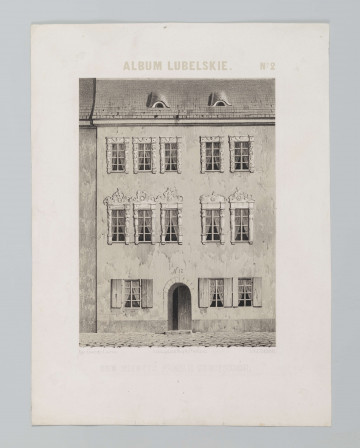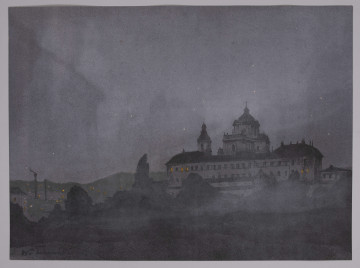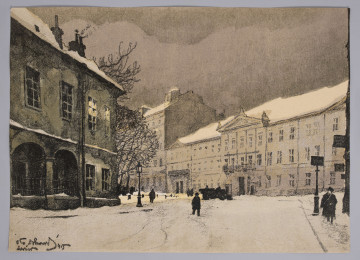
House formerly owned by the Sobieski family
1857
National Museum in Lublin
Part of the collection: Lubliniana. Painting views of Lublin and the Lublin Region (17th–early 20th c.)
One of the aspects of the 19th century activities related to researching and learning about the relics of the national past was striving to preserve and document the condition of buildings in order to spread knowledge about the monuments of national architecture, especially those reminiscent of the past splendour and significance of places important for the free and independent homeland in a country devoid of sovereignty. This was one of the purposes of the so-called picturesque albums, popular in the 19th century, which contained engravings with views of buildings, usually accompanied by short descriptions. The first publications of this type appeared in Poland at the beginning of the 19th century and gained popularity in the second half of the century. Thanks to the efforts of Adam Lerue, one of the most distinguished artists in the field of inventory of Polish monuments, also the town on the Bystrzyca River had its own album. The drawings and watercolours by Lerue, depicting the most important architectural objects of the city, were created during the inventory of historical monuments carried out in 1844-1855 by the Delegation for the description of old monuments in the Kingdom of Poland, headed by Kazimierz Stronczyński. They were included in the Lubelskie Album published in 1857-1859 by the Lithographic Company of Adolf Pecq and Co. in Warsaw in a two-part form. The four sheets contained in the first part included sixteen views of Lublin monuments translated into the language of lithography by Julian Cegliński and Władysław Walkiewicz. Each print was accompanied by a caption with the name of the building, sometimes extended to include the name of the founder or a short description proving the “distant past” of the building.
Among several Old Town views, Lerue included in the portfolio a view of the Market Square, shown from Krakowska Gate towards Grodzka Street, with a fragment of the Tribunal on the right-hand side and the corner of the Chociszewska tenement house. The left part of the representation is occupied by a sequence of tenement houses on the Market Square and Grodzka Streets leading towards Grodzka Gate. A former well, which was demolished around 1931, is shown in front of the Tribunal. The representation is devoid of purely documentary character - Lerue introduced extensive staffage, showing silhouettes of passers-by dressed in elegant clothes, as well as the everyday life of the residents of this part of the city, focused on their work.
Anna Hałata
Author / creator
Dimensions
cały obiekt: height: 21,5 cm, width: 18 cm
Object type
graphics
Technique
lithography
Material
paper
Creation time / dating
Creation / finding place
Owner
The National Museum in Lublin
Identification number
Location / status

1857
National Museum in Lublin

1915
National Museum in Lublin

1915
National Museum in Lublin
DISCOVER this TOPIC
Castle Museum in Łańcut
DISCOVER this PATH
Educational path